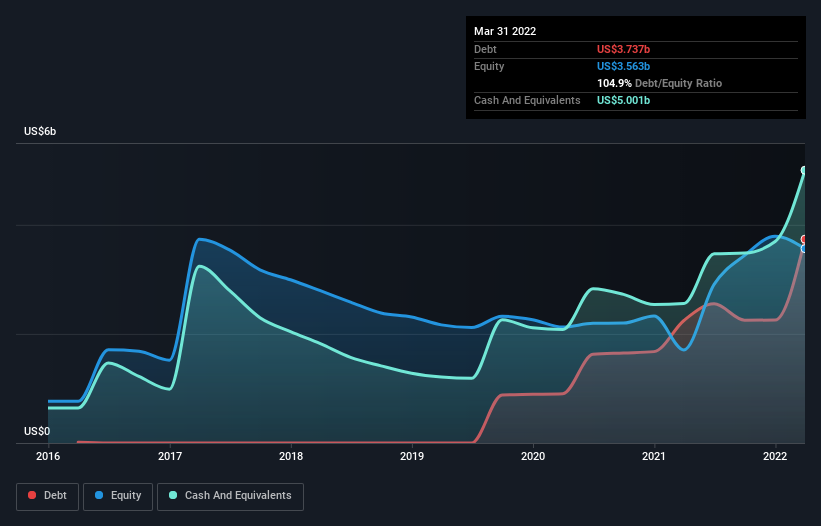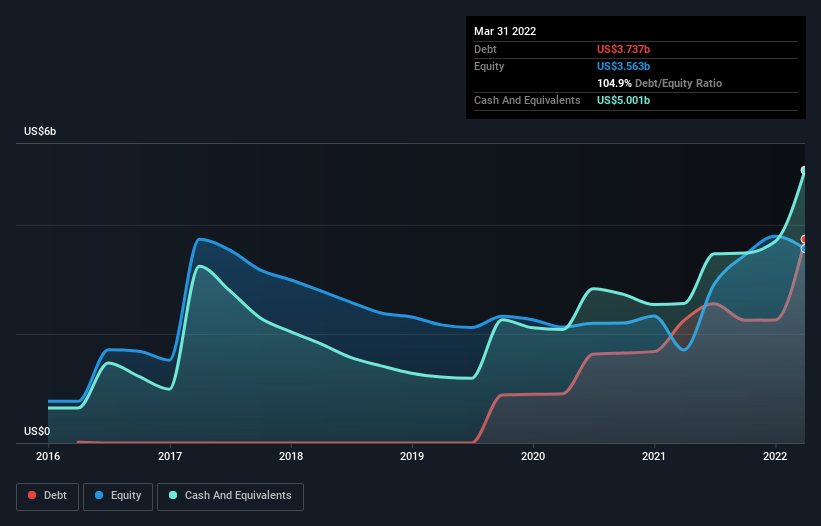The external fund manager backed by Berkshire Hathaway’s Charlie Munger, Li Lu, makes no bones about it when he says ‘The biggest investment risk is not the volatility of prices, but whether you will suffer a permanent loss of capital.’ So it seems the smart money knows that debt – which is usually involved in bankruptcies – is a very important factor, when you assess how risky a company is. As with many other companies Snap Inc. (NYSE:SNAP) makes use of debt. But is this debt a concern to shareholders?
Why Does Debt Bring Risk?
Generally speaking, debt only becomes a real problem when a company can’t easily pay it off, either by raising capital or with its own cash flow. In the worst case scenario, a company can go bankrupt if it cannot pay its creditors. While that is not too common, we often do see indebted companies permanently diluting shareholders because lenders force them to raise capital at a distressed price. Having said that, the most common situation is where a company manages its debt reasonably well – and to its own advantage. The first thing to do when considering how much debt a business uses is to look at its cash and debt together.
Check out our latest analysis for Snap
What Is Snap’s Debt?
The image below, which you can click on for greater detail, shows that at March 2022 Snap had debt of US$3.74b, up from US$2.25b in one year. However, its balance sheet shows it holds US$5.00b in cash, so it actually has US$1.26b net cash.
How Strong Is Snap’s Balance Sheet?
We can see from the most recent balance sheet that Snap had liabilities of US$842.8m falling due within a year, and liabilities of US$4.54b due beyond that. Offsetting this, it had US$5.00b in cash and US$941.7m in receivables that were due within 12 months. So it can boast US$560.8m more liquid assets than total liabilities.
This surplus suggests that Snap has a conservative balance sheet, and could probably eliminate its debt without much difficulty. Simply put, the fact that Snap has more cash than debt is arguably a good indication that it can manage its debt safely. The balance sheet is clearly the area to focus on when you are analysing debt. But ultimately the future profitability of the business will decide if Snap can strengthen its balance sheet over time. So if you want to see what the professionals think, you might find this free report on analyst profit forecasts to be interesting.
In the last year Snap wasn’t profitable at an EBIT level, but managed to grow its revenue by 57%, to US$4.4b. With any luck the company will be able to grow its way to profitability.
So How Risky Is Snap?
Although Snap had an earnings before interest and tax (EBIT) loss over the last twelve months, it generated positive free cash flow of US$203m. So taking that on face value, and considering the net cash situation, we don’t think that the stock is too risky in the near term. We think its revenue growth of 57% is a good sign. We’d see further strong growth as an optimistic indication. When analysing debt levels, the balance sheet is the obvious place to start. However, not all investment risk resides within the balance sheet – far from it. For instance, we’ve identified 3 warning signs for Snap (1 makes us a bit uncomfortable) you should be aware of.
Of course, if you’re the type of investor who prefers buying stocks without the burden of debt, then don’t hesitate to discover our exclusive list of net cash growth stocks, today.
Have feedback on this article? Concerned about the content? Get in touch with us directly. Alternatively, email editorial-team (at) simplywallst.com.
This article by Simply Wall St is general in nature. We provide commentary based on historical data and analyst forecasts only using an unbiased methodology and our articles are not intended to be financial advice. It does not constitute a recommendation to buy or sell any stock, and does not take account of your objectives, or your financial situation. We aim to bring you long-term focused analysis driven by fundamental data. Note that our analysis may not factor in the latest price-sensitive company announcements or qualitative material. Simply Wall St has no position in any stocks mentioned.
Join A Paid User Research Session
You’ll receive a US$30 Amazon Gift card for 1 hour of your time while helping us build better investing tools for the individual investors like yourself. Sign up here












Add Comment